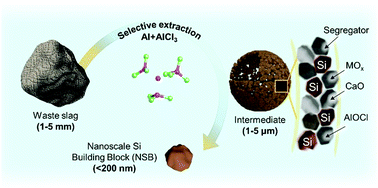Salt-mediated extraction of nanoscale Si building blocks: composite anode for Li-ion full battery with high energy density†
Abstract
The agglomerating nature of nanomaterials during the preparation degrades the unique properties of nanostructured materials even in controlled metallothermic reactions. Here, we introduce a molten salt-mediated extraction of nanoscale (but high-quality) silicon building blocks from industrial wastes without unfavorable pretreatments. Selective reduction of silica using reactive complex reducing agents produces segregated nanosized silicon embedded in an inactive impurity matrix. Inert impurities in the unprocessed wastes are likely to dissolve in the mild etching condition after the reduction process. The resulting silicon has a defect-less structure with elemental high purity, which improves the initial electrochemical reversibility and cycle stability compared with those of commercial silicon nanoparticles even with smaller particle size. When incorporated with carbon layers and blended with traditional graphite at a high silicon content (~20 wt%), the formulated composite anodes showed high initial Coulombic efficiency and capacity retention over hundreds of cycles, thus enabling the practical demonstration of high energy full cells. The proposed cost-effective, efficient, and selective extraction of unavoidable industrial wastes can be extended to the preparation of segregated nanomaterials for various energy applications.



 Please wait while we load your content...
Please wait while we load your content...